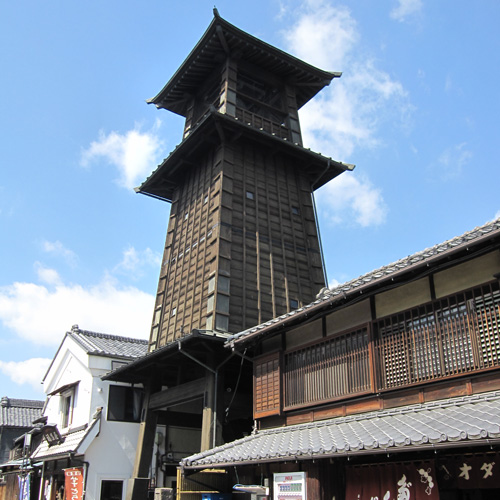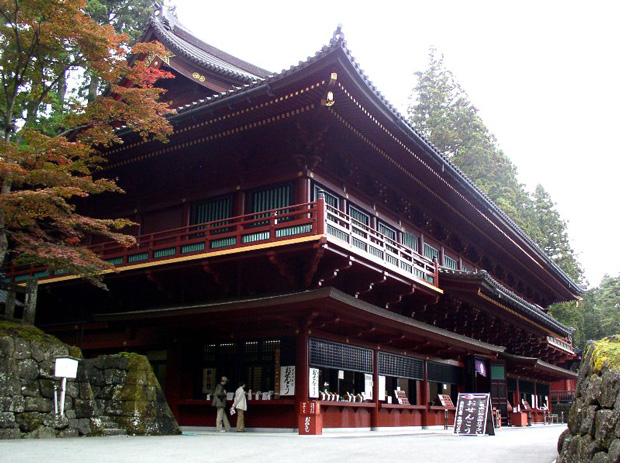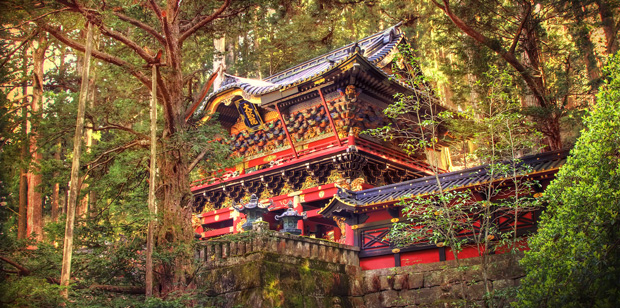by Sara Kanematsu
Kawagoe
A stroll through the streets of central Tokyo delivers the disarming impression of being in two places at once. With enough stores to satisfy even the most finicky shopaholic and restaurants delivering any kind of cuisine one could wish for, Tokyo is a distinctively cosmopolitan, international haven. And yet turn a corner or head down a side street and one is sure to find something uniquely Japanese—a yakitori vendor on the street, a small store selling kimonos, or a shrine or temple that looks like it belongs on a Yokoso! Japan postcard.
While there are several areas within central Tokyo that offer a taste of more traditional Japanese culture—Asakusa and Meiji Jingu being the two main attractions for tourists—a simple train ride can provide a more thorough immersion into the best of what Japan really has to offer in terms of culture and tradition. And if a vacation in Kyushu sounds like too great of an undertaking, then a day trip or weekend in Kawagoe or Nikko might be the perfect solution, as each city has the ability to literally transport visitors back in time into a vastly different Japan.
With autumn bringing wonderful warm foliage and a much-needed respite from the sweltering heat of a Tokyo summer, October makes for the perfect month to travel. Only 30 minutes by train from Ikebukuro, Kawagoe is a city in Saitama that seeks to give visitors a taste of a more historical Japan, or more specifically, Edo. Also known as Koedo, or ‘Little Edo,’ Kawagoe contains a number of streets that have been preserved in the style of the Edo period.
The city certainly delivers on its promise to transport visitors back to the Edo period, as a stroll down Kurazukuri Street quickly demonstrates. Lined with traditional kurazukuri warehouses that are perfectly preserved in the architectural style of the Edo period, the street immerses visitors in the nostalgic atmosphere conjured up by the wooden buildings. One can even explore the inside of a warehouse and reenact a day in the life of an Edo merchant by visiting the Kawagoe Kurazukuri Museum. These remarkable buildings evoke the startling impression of truly having moved backwards in time, each made in a unique fashion, with the oldest dating back to 1792.
Another must-see is the iconic Toki no Kane bell tower, originally built by Sakai Tadakatsu around 400 years ago. Although the original tower was burned down, it was rebuilt and continues to stand tall today, watching over the city and ringing out distinctly four times a day. Designated a symbol of Koedo and forming a truly impressive sight as it towers over the adjoining buildings, a vivid relic from the past existing in the present, it is definitely worth a visit and makes for some wonderful photo opportunities.
As one wanders the streets of Kawagoe and starts to feel the beginning pangs of hunger, a wonderful place to stroll through is Kashiya Yokocho, a quaint street boasting numerous old-style stores that sell all sorts of traditional sweets and snacks. Kawagoe is famous for its sweet potato, which is clearly evident by the selection of sweet potato treats that can be found, and with everything from sweet potato chips to sweet potato ice cream, there is something for everyone. This is also an excellent place to pick up a tasty souvenir or two!
For those looking for a taste of Japanese culture, look no further than Kitain Temple. While Japan boasts a myriad of temples guaranteed to astound even the most well traveled of tourists, Kitain Temple in Kawagoe is unique because of its interesting historical background. Originally built in 830, the original structure was destroyed by a fire, and Shogun Iemitsu donated several structures from Edo Castle to aid with its rebuilding.
These buildings are now all that remain of Edo Castle, as the 1923 Tokyo Earthquake and World War II destroyed the original castle, and the
structures are protected as national treasures.
Traditional kurazukuri warehouses that are perfectly preserved in the architectural style of the Edo period immerse visitors in a nostalgic atmosphere.
Also on the Kitain Temple grounds is the Semba Toshogu Shrine. One of Japan’s three major Toshogu shrines, it sports remarkable colors and intricate carvings. While visiting the shrine, visitor’s shouldn’t miss a visit to the 500 Statues of Rakan. These are in fact 540 statues, all carved between 1782 and 1825, representing Buddha’s disciples. No two are alike, and it is fascinating to wander amongst the statues and discern exactly what makes each unique. Additionally, with so many faces, expressions and personalities to choose from, you might just happen to be lucky enough to stumble across your own doppelgänger!
Kawagoe boasts a whole variety of different museums. One of the most interesting is the Kawagoe Festival Museum, which displays huge traditional floats that are brought out annually for the Kawagoe Festival. This festival is held every year on the third Saturday and Sunday of October, and is a truly extraordinary event to attend. The floats are towering multi-tiered structures embellished with lanterns, carvings and intricately designed fabrics. Weighing up to seven and a half tons, these floats parade through the city in the midst of large processions of people and traditional Edo-bayashi festival music. The festival goes back 350 years, and each year floats proceed down different streets until they meet at the corner in a thrilling climax of lights and color, colliding into each other in a competition as the music reaches a crescendo. Each float is crafted to be unique, and they are most spectacular when viewed in the nighttime, lit by the glow of lanterns.
Extravagantly ornamented and comprising over a dozen buildings, the shrine is worth visiting simply to admire its elaborate carvings.
Nikko
Japanese festivals are electrifying events that every tourist must experience at least once, with their high energy, elaborate costumes and unique history. Often, they turn a town that is already known for its wealthy cultural history into an unmissable travel destination. This is certainly true for Nikko, a city located in Tochigi prefecture, less than two hours away from Tokyo. It is far enough to get well and truly away from the city throngs, but close enough to make for a truly enjoyable weekend escape before returning, rejuvenated, for another week at work.
Usually a serene city surrounded by breathtaking scenery and nature, the streets of Nikko are brought alive during the Shuki Taisai Grand Autumn Festival, also held in the month of October. This festival is most well known for the Hyakumono-Zoroe Sennin Musha Gyoretsu, or Parade of 1,000 Samurai Warriors. During this parade, men dressed in traditional samurai costumes proceed through the streets of Nikko, sporting guns, spears, bows and arrows, along with a mikoshi shrine and a crowd of 800 people, until they arrive at the Otabisho, a temporary resting site for the procession.
The parade transports onlookers back to the 17th century, recreating the funeral of Tokugawa Ieyasu, the first Shogun of Tokugawa, Standing in the grounds of the Nikko Toshogu Shrine, watching the parade of samurai move majestically past, it is remarkably easy to be lost in the costumes and surroundings, utterly forgetting about modern day Tokyo.
For those interested in reliving the lives of samurai more completely, there is also a yabusame contest held the night before the festival and parade. It features a performance of equestrian and traditional Japanese archery skills, popular amongst samurai of the Heian and Kamakura Period, where the archer displays astounding skill and precision, shooting at three successive targets while riding on horseback.
While the festival makes for an extraordinary cultural experience and offers a taste of Japan in a vastly different time period, there is much more to explore and experience when visiting Nikko. The city offers numerous sites of vast cultural importance, and the Toshogu Shrine where the autumn festival is held is also the site where Tokugawa Ieyasu was buried.
Extravagantly ornamented and comprising over a dozen buildings, the shrine is worth visiting simply to admire the elaborate carvings of patterns and animals, which sport stunningly bright colors and unique detailing. With a shrine so large, it is nearly impossible to point out all the areas of note when visiting, as it includes beautiful torii gates, a five-storied pagoda, a prayer hall, an okusha inner shrine where Ieyasu’s body was buried, and many more fascinating areas to explore. It is certainly an awe-inspiring experience simply standing before the entrance alone and reveling in its remarkable beauty. One particularly noteworthy story, however, is that of the three monkeys, a tale connected to a sculpture found on the Shinyosha, or Sacred Stable. It contains eight panels depicting images of monkeys that tell the story of life, from childhood to parenthood. The carving of childhood shows three monkeys that illustrate the proverbial principle to “see no evil, hear no evil, speak no evil,” with one covering his eyes, another his ears, and the third his mouth. Closer examination of the carvings decorating the shrine will reveal many more interesting figures such as these.
Venturing further from the city brings one into vast landscapes of stunning beauty, as Nikko offers a wealth of natural attractions that will capture the imagination of the most cynical of tourists. About an hour’s drive from Nikko city is Nikko National Park, spanning over four prefectures and approximately 200,000 acres. With its majestic mountains, volcanic craters, forests, plateaus, sparking lakes and a myriad of thundering waterfalls on offer, there is no better backdrop amidst which to enjoy the transition of seasons, as the autumn leaves take on their brilliant bronze shades.
Whether shrouded in the natural beauty of Nikko, strolling through the streets of Old Edo, or participating in the rich revelry of a traditional Japanese festival, Japan has much to offer, and often one need not look very far to be fascinated or astounded anew. It is hard to believe a brisk train ride is all it takes to take us someplace that feels a world away from Tokyo’s cosmopolitan metropolis. But as any true Tokyoite will proudly declare, this is precisely what gives the city its unique, timeless, ineffable appeal.
Updated On December 26, 2022














